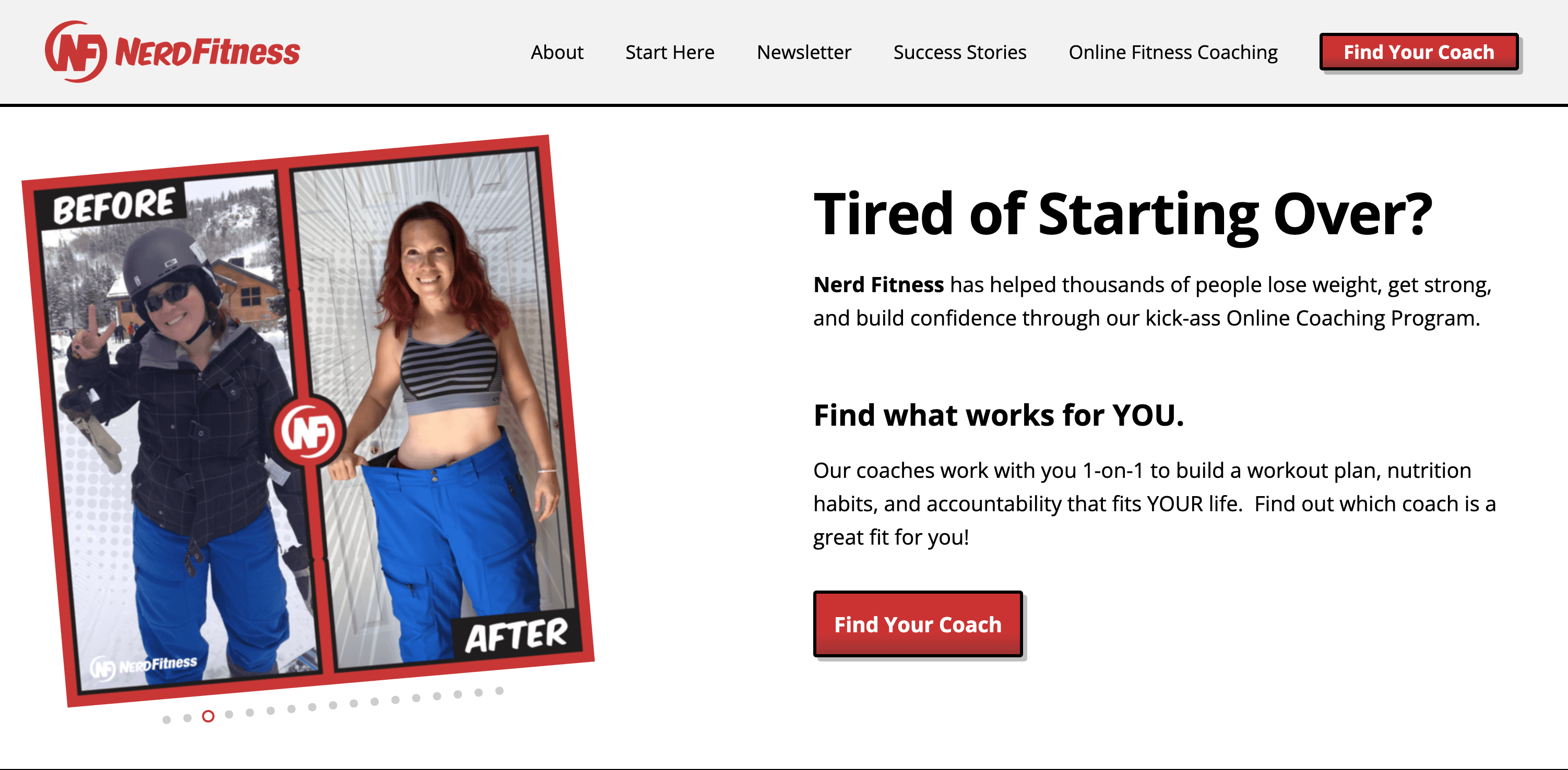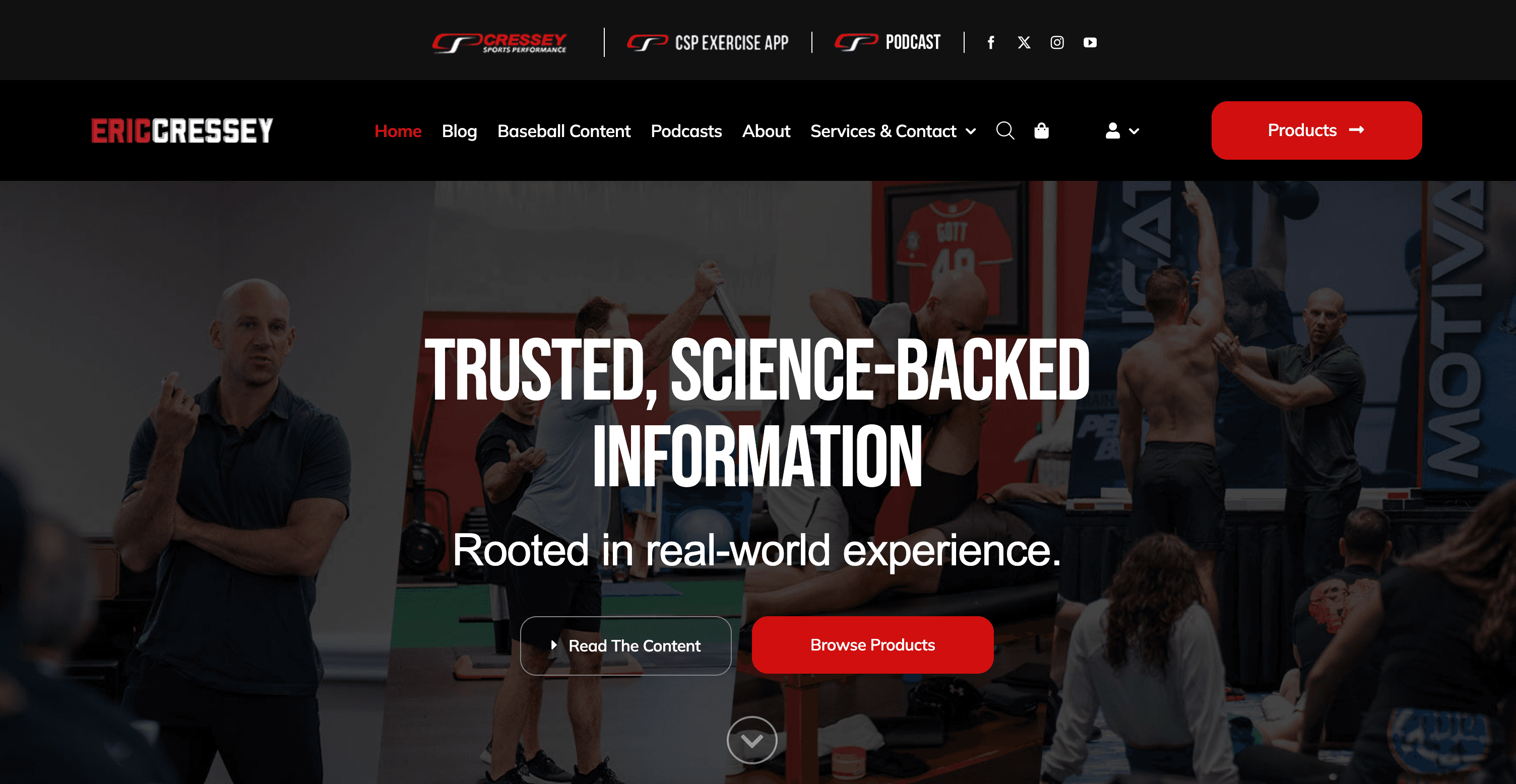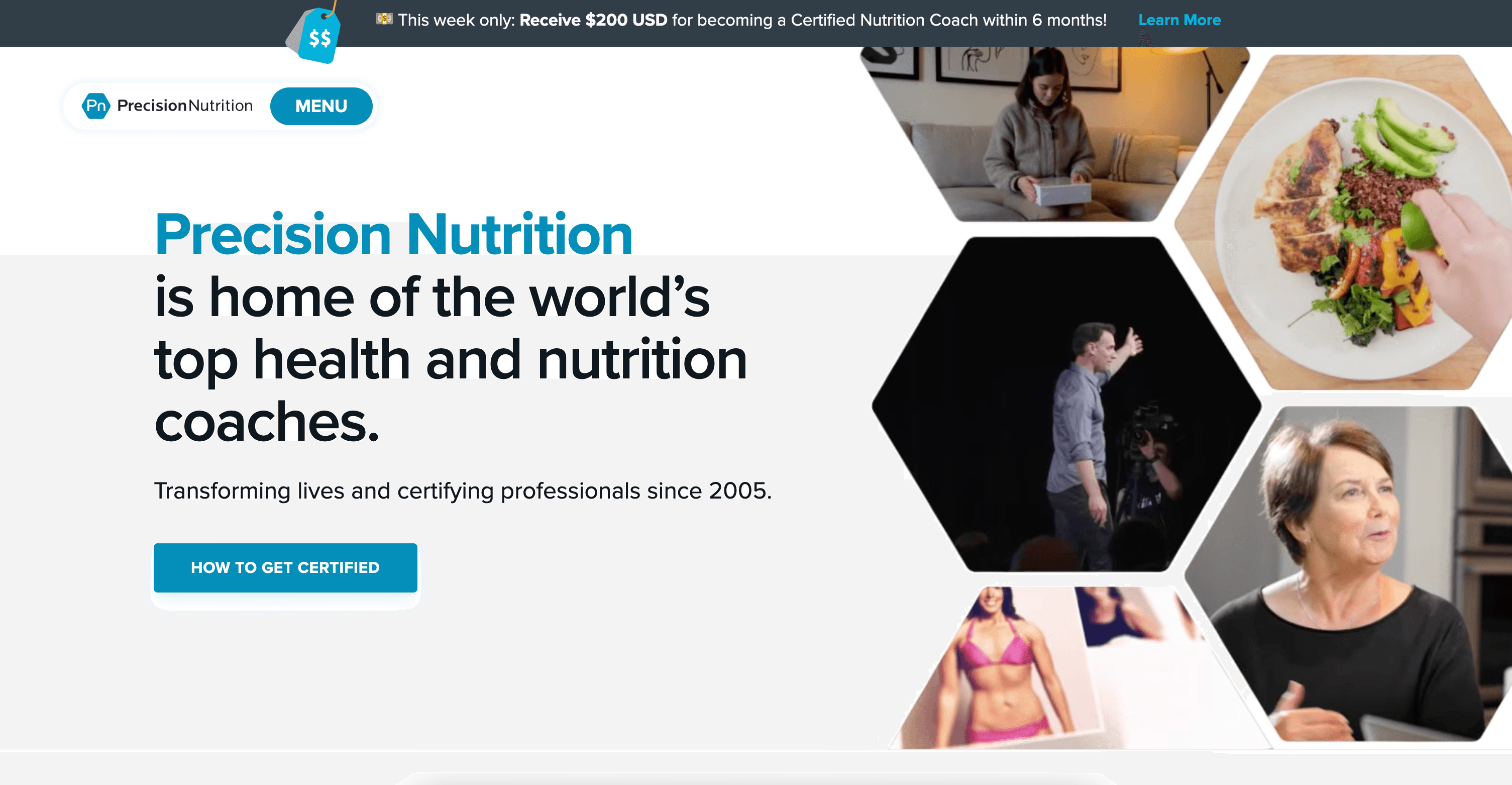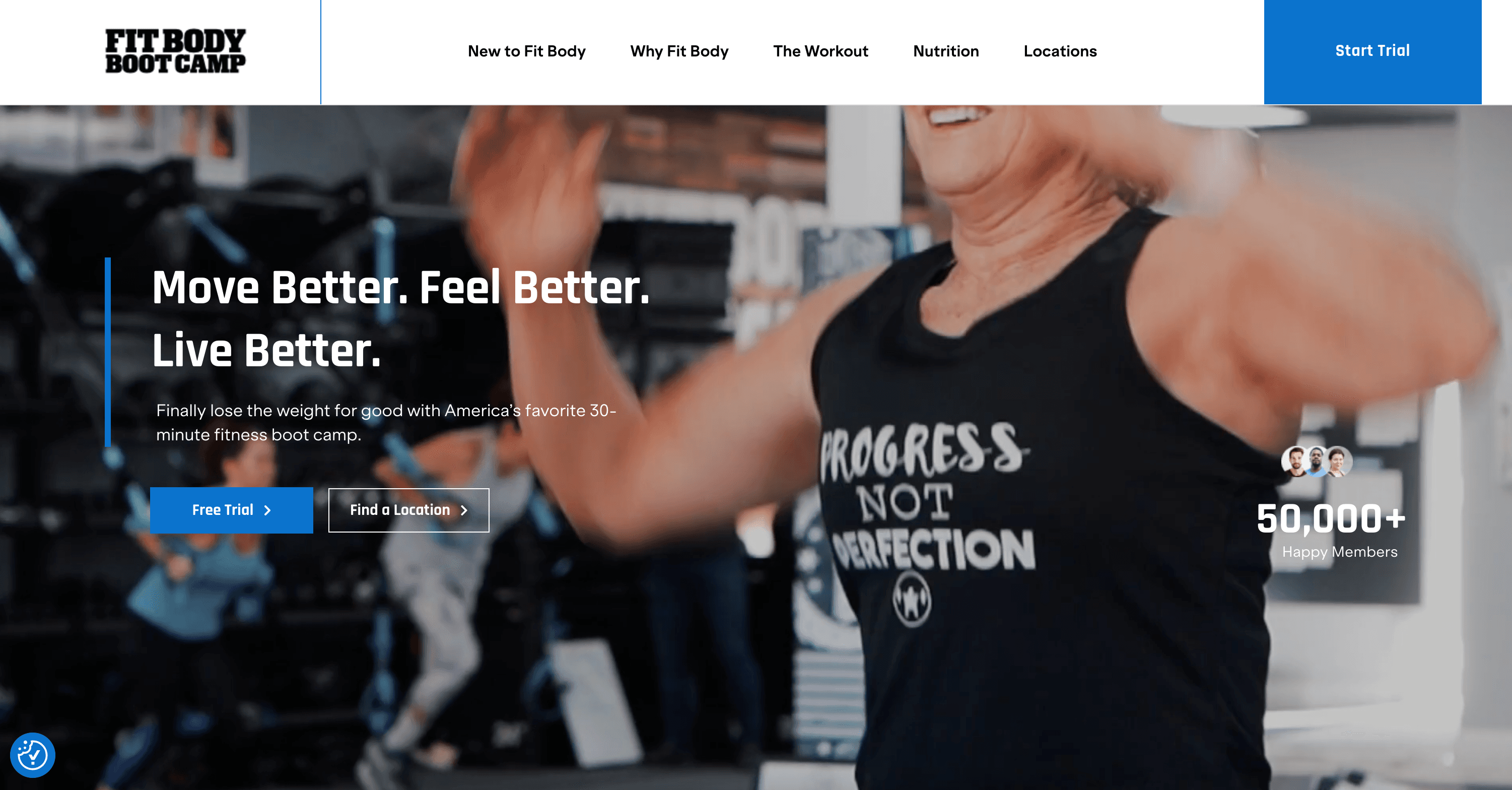Looking to build a professional website for your personal training business? Whether you're just starting out or giving your current site a refresh, the right website can help you build trust, attract new clients, and grow your fitness business online.
In this post, we've gathered some of the best personal training website examples — from big names to small business owners like you — to help inspire your next move.
Best Personal Training Website Examples
Here's a round-up of the best website designs from real personal training businesses. These sites not only look great — they're built to convert visitors into customers.
#1. Nerd Fitness

- What they do: Online coaching and resources for self-proclaimed "nerds" who want to get fit using gamified approaches and relatable content
- What stands out: Exceptional storytelling, clear ideal personal training client targeting, and community-building elements that create belonging. Their homepage instantly communicates who they serve with bold messaging and approachable imagery.
- Website link: nerdfitness.com
- Expert insight: Nerd Fitness brilliantly demonstrates niche targeting by speaking directly to a specific audience rather than trying to appeal to everyone. Their consistent branding across all pages creates an immersive experience that makes potential clients feel "this is for me" – a conversion strategy all personal trainers should implement.
#2. Mark Fisher Fitness

- What they do: In-person and online personal training with a uniquely inclusive, fun approach that breaks fitness industry stereotypes
- What stands out: Bold, colorful design with unicorn branding and playful language that immediately differentiates them from traditional gyms. Their client transformation stories are front and center, building immediate credibility.
- Website link: markfisherfitness.com
- Expert insight: Mark Fisher Fitness demonstrates how personality-driven design can create instant brand recognition. While many training sites use similar stock photos and generic promises, MFF's authentic voice creates an emotional connection that drives higher engagement and conversion rates.
#3. Eric Cressey Performance

- What they do: Specialized strength and conditioning coaching with a focus on athletes, particularly baseball players
- What stands out: Clean, professional design with clear service segmentation based on client type (professional athletes, serious amateurs, general population). Their content strategy showcases deep expertise through video demonstrations and case studies.
- Website link: ericcressey.com
- Expert insight: Cressey's site excels at positioning him as the authority in his niche through strategic content organization. Unlike general fitness sites, his education-first approach builds trust with a clientele seeking specialized results, proving that expertise-focused design drives premium pricing opportunities.
#4. Precision Nutrition

- What they do: Nutrition coaching certification and programs that many personal trainers use to enhance their service offerings
- What stands out: Exceptional user experience with intuitive navigation, clear conversion paths, and sophisticated use of white space. Their calculator tools and self-assessment quizzes create interactive engagement.
- Website link: precisionnutrition.com
- Expert insight: Precision Nutrition's website excels in guiding visitors through a logical journey from initial interest to action. Their strategic use of free tools and calculators creates immediate value while collecting leads – a technique personal trainers can implement even on smaller sites.
#5. Fit Body Boot Camp

- What they do: Franchise-based group personal training with locations nationwide, offering high-energy, results-focused workouts
- What stands out: Location-based personalization that immediately directs visitors to their nearest location, powerful before/after imagery, and friction-reducing trial offers prominently displayed.
- Website link: fitbodybootcamp.com
- Expert insight: FBBC's website demonstrates masterful local SEO integration with global brand consistency. Each location page maintains core messaging while featuring location-specific elements – an excellent template for personal trainers with multiple locations or who target specific neighborhoods.
Each of these standout personal training websites employs different strategies, but they share common elements:
- clear target audience identification
- credibility-building content
- strategic conversion pathways
Each of these guide potential clients from curious visitors to paying customers. As you design your own personal training website consider which of these approaches best aligns with your unique training philosophy and client base.
What Makes a Great Personal Training Business Website?
If you're figuring out how to start a personal training business, or redesigning your existing site, here are a few tips to keep in mind.
Tip #1: Showcase your unique training philosophy and approach
The personal training market is crowded, so your website needs to clearly communicate what makes your approach different. This goes beyond just listing credentials—explain your training methodology, core values, and who your ideal clients are.
For example, if you specialize in training busy professionals with 30-minute efficient workouts, make that clear immediately. Your unique selling proposition should be evident within seconds of someone landing on your homepage, setting expectations and helping potential clients self-qualify.
Tip #2: Feature authentic transformation stories and results
Nothing sells personal training services like proof they work. Include detailed client success stories that go beyond just before/after photos—share the journey, challenges overcome, and specific metrics achieved.
The most effective testimonials include relatable client profiles that potential customers can see themselves in. Include video testimonials when possible, as they create stronger emotional connections than text alone.
Make sure to get proper releases and permissions from clients before sharing their stories.
Tip #3: Create a simple booking and consultation process
The path from interested visitor to booked client should be frictionless.
Every page on your site should include a clear call-to-action, whether it's booking a free consultation, signing up for a trial session, or subscribing to your fitness newsletter. Implement an online scheduling system that allows prospects to book directly without phone calls or email exchanges.
Research shows that each additional step in the booking process reduces conversion rates by 20-30%, so aim for a maximum of 3 clicks from interest to confirmation.
Tip #4: Develop valuable free content that establishes expertise
High-performing personal training websites don't just sell services—they educate and provide value upfront. Create a content strategy that includes blog posts, workout videos, nutrition guides, or fitness assessments visitors can use immediately.
This approach positions you as an authority while giving prospects a "sample" of your expertise. The most successful trainers typically publish new content at least twice monthly and repurpose it across their social channels for maximum visibility and engagement. This counts toward your marketing efforts and brand building all in one go.
Read our guide to: Marketing for Personal Trainers.
Tip #5: Optimize for local search and mobile users
Most personal training clients search locally, making local SEO critical for business growth. Include your city and neighborhood names naturally throughout your site, embed a Google Map showing your location, and ensure your Google Business Profile is complete with current photos and information. Since over 70% of fitness searches now happen on mobile devices, ensure your website is fully responsive with tap-friendly navigation, fast loading times, and mobile-optimized contact forms. A one-second delay in mobile load time can reduce conversions by up to 20%.
Personal Training Website Examples FAQs
What should a personal training website include?
A great personal training website should include clear service descriptions (including packages and pricing), trainer credentials and philosophy, client transformation stories, a fitness blog or resources section, professional photos/videos of you training clients, contact information, social proof (reviews/testimonials), and prominent call-to-action buttons for consultations or trial sessions. Not only will these things help your SEO, they will also help you appear in ChatGPT when people search for personal trainers.
How much does it cost to build a personal training business website?
It depends—DIY options like Durable start from $14/month, while hiring a designer can cost several thousand dollars. Most personal trainers find that website builders with personal training website templates offer the best balance of professional design and affordability, with complete websites ranging from $150-500 per year including hosting and maintenance.
Can I build a personal training website without coding?
Yes! Website builders like Durable allow you to create a website for personal trainers no design or coding experience. Modern AI-powered platforms can generate a complete personal training website based on your business information, then allow you to customize elements like colors, fonts, and content without touching a line of code.
How do I showcase client transformations effectively on my website?
The most effective client transformations include before/after photos alongside detailed stories that highlight the client's journey, challenges, and specific results (weight lost, strength gained, races completed, etc.). Always get written permission before posting client results, use consistent photography (same lighting/angles) for before/after comparisons, and include demographic details so potential clients can find stories they relate to.
Do I need different websites for in-person vs. online personal training?
Not necessarily. Many successful trainers use a single website with clearly defined service sections for both in-person and online offerings. The key is having distinct pages with specific benefits and sign-up processes for each service type. If online training becomes your primary business model, you might consider a dedicated site that emphasizes your digital programs, video content quality, and virtual coaching approach.
What's the most important page on a personal trainer's website?
While the homepage gets the most traffic, the "About" page is often where potential clients make their hiring decision. Unlike other industries where services and pricing are the deciding factors, personal training is relationship-based. Clients want to know your story, approach, and personality before committing to work with you. Invest extra time in crafting an authentic, engaging About page that connects with your ideal clients on both professional and personal levels.
Build Your Personal Training Website in Minutes
Creating a professional personal training website doesn't require technical skills or a massive budget. With Durable, you can create a custom fitness website in minutes — complete with online booking capabilities, before/after galleries, client testimonials, and even automatic posting of workout content. Many successful trainers have launched their online presence in a single day using our industry-specific templates designed to convert fitness-minded visitors into paying clients. Start with a free trial today and have your professional training website live before your next client session.

